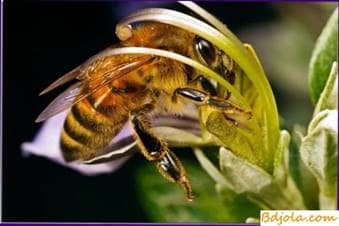
Honey. Honey bees are produced from nectar collected from the flowers of plants. Nectar is an aqueous solution of complex and simple sugars. The sugar content of nectar depends on the type of plants, night and daytime outdoor temperature, soil and air humidity, time of day and many other conditions.
Bees prefer to collect nectar from plants closer to the apiary, with a high content of nectar and increased sugar content.
Collecting nectar, bees suck it with proboscis. Simultaneously, the secret of the pharyngeal gland containing the enzyme invertase is added to the nectar, as a result; that the nectar accumulated in the honey crocus changes its properties. Contained in a significant amount of cane sugar begins to split into simple sugars – fructose and glucose. Fructose (fruit sugar) almost does not crystallize, easily absorbs moisture and is almost 2 times sweeter than glucose (grape sugar), which crystallizes faster and dries out. The quality of honey depends on the quantitative ratio of these sugars.
The nectar brought by the bee to the beehive is transmitted through the proboscis to the beehive-beehive bees. The receiver repeatedly releases nectar on the proboscis and again draws into the honey cind. After this treatment, the nectar is suspended in droplets in the cells. This is done in order to quickly remove excess moisture and prevent souring and molding of the product. Nectar brought and placed in cells is called a spray.
To create a draft of air, many hundreds, and maybe thousands of bees, on the bottom, the framework, the walls and the landing board of the hive, by means of the vibration of the wings, create such a stream of air that it extinguishes the lighted match brought to the tap. On the first day more than half of the water evaporates from the nectar, and on the sixth day the biological process of turning nectar into honey ends. Honey from nectar differs not only in the concentration of simple sugars, but also in physical and chemical composition. Honey is enriched with protein substances, vitamins, enzymes, trace elements (there are about 100 different substances in it).
Fall. In addition to nectar, in some years, bees are collected and introduced into the beehive in a beehive without a hint. Decay separates parasites on plants of aphids, leaf-blocks and chervets. Feeding on cell sap, parasites consume it in large quantities to satisfy the body’s need for protein substances. Excess of sugars they allocate as waste.
The drop differs from honey with increased viscosity and viscidity, usually has a dark color, without a fragrant smell. Honey comb does not crystallize, bees are not printed and have a peculiar, sometimes unpleasant aftertaste.
Falling honey (and even its admixtures to natural honey in winter) as food is harmful to bees. The poisoning effect on bees is exerted by mineral salts and decay products of its protein.
Honeydew. Honey dew is called sweet secretions, appearing on leaves, cuttings and even on tree trunks as a result of the swelling of the cell sap of plants during sudden fluctuations in air temperature on hot days and cold nights. Honey dew is isolated cells of plants of lime, maple, oak, ash, hazel, and also some cruciferous and grassy herbaceous plants.
The chemical composition of honey dew differs little from nectar and is less harmful to bees than pade honey. Since honey dew is not very often allocated and it is difficult to distinguish it from insect secretions, it is customary to call it a plant-derived drop.
Pollen. The second not less important food for bees is flower pollen. Pollen is the main source of protein, vitamin and mineral nutrition of bees.
In early spring pollen is produced in large quantities by wind-pollinated plants: hazel, alder, birch, aspen, poplar, but with a flowering willow, maple, dandelion and other insect-polluted plants, bees give preference to them.

Bees collect pollen in baskets located on the lower leg of the hind legs, in the form of updates. According to the color of the updates (Table 2), you can, without leaving the apiary, determine which plant it is harvested, where the bees fly for a bribe and plan the carrying out of the corresponding works on the apiary.
Usually bees collect an update from one plant species, but there are insignificant pollen pollen from other plants, which changes the color of the main update. The color of the renewal also varies depending on the degree of wetting of the pollen with honey and saliva, its compaction, the color of the honey used for wetting, and also the stage of flowering of the plant.
The largest number of bees are collected in the spring. In the summer, bees collect the update only in the morning, it is heavier than the spring and autumn. The average weight of two updates, brought to the hive by bees in spring and autumn, ranges from 8 to 12 mg, and in the summer – from 16 to 24 mg. To collect the bee update, one flight takes from 30 minutes to 2 hours.
The brought bees are stored only in bee cells. Then they are densely laid and compacted by non-flying beehive bees. Since for the compaction of pollen bees a support is needed, the cells are filled only by 6-9 mm.
Under the influence of enzymes in the cell there is a chemical change in the pollen. Sugar under the influence of bacteria is processed into lactic acid, which has preservative properties. The product is called perga. Perga in comparison with pollen contains more sugar (however, due to the presence of lactic acid it tastes acidic), but less – fat and protein. On the average, 140 mg of Perga are contained in one cell, and in the Dadanovsky frame, which is completely occupied by the Perga, its amount is about 1 kg.
With a lack of Perga bees eat more food, they consume the protein reserves of their body.
Облет пчел в теплице. Ту для запилення.
Hothouse beekeeping